
Agostino Carracci was an Italian painter, printmaker, tapestry designer, and art teacher. He was, together with his brother, Annibale Carracci, and cousin, Ludovico Carracci, one of the founders of the Accademia degli Incamminati in Bologna. This teaching academy promoted the Carracci emphasized drawing from life. It promoted progressive tendencies in art and was a reaction to the Mannerist distortion of anatomy and space. The academy helped propel painters of the School of Bologna to prominence.
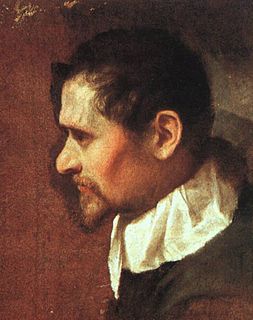
Annibale Carracci was an Italian painter and instructor, active in Bologna and later in Rome. Along with his brother and cousin, Annibale was one of the progenitors, if not founders of a leading strand of the Baroque style, borrowing from styles from both north and south of their native city, and aspiring for a return to classical monumentality, but adding a more vital dynamism. Painters working under Annibale at the gallery of the Palazzo Farnese would be highly influential in Roman painting for decades.
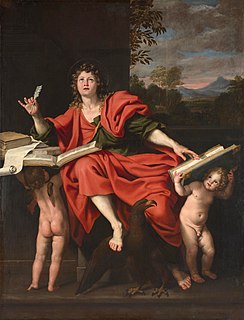
Domenico Zampieri, known by the diminutive Domenichino after his shortness, was an Italian Baroque painter of the Bolognese School of painters.
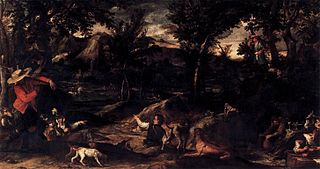
Hunting is a painting by Italian artist Annibale Carracci, painted before 1595 and given to Louis XIV by Prince Camillo Pamphili in 1665. It is currently held and exhibited at the Louvre in Paris.

The Carracci were a Bolognese family of artists that played an instrumental role in bringing forth the Baroque style in painting. Brothers Annibale (1560–1609) and Agostino (1557–1602) along with their cousin Ludovico (1555–1619) worked collaboratively. The Carracci family left their legacy in art theory by starting a school for artists in 1582. The school was called the Accademia degli Incamminati, and its main focus was to oppose and challenge Mannerist artistic practices and principles in order to create a renewed art of naturalism and expressive persuasion.

The Vision of Saint Eustace is a painting by Annibale Carracci, showing saint Eustace and his vision of a crucifix between the horns of a stag whilst out hunting. The saint is set in one of the first landscapes by either of the Carracci brothers, showing how he was influenced by Venetian landscape painting until about 1598 after a stay in the city in 1587 and 1588. Specific influences include Titian's Penitent Saint Jerome (Louvre) and the naturalism of Jacopo Bassano. Critics argue the composition is based on two prints by Cornelis Cort, a Flemish printer - Penitent St Jerome and The Vision of Saint Eustace. These prints were in turn based on ideas by the Lombard painter Girolamo Muziano, who was also influenced by Venetian models. The dogs and some other details are drawn from Saint Eustace, an engraving by Albrecht Dürer of the same subject.

Pietà is a c.1600 oil on canvas painting by Annibale Carracci, the earliest surviving work by him on the subject, commissioned by Odoardo Farnese. It moved from Rome to Parma to Naples as part of the Farnese collection and is now in the National Museum of Capodimonte in Naples.

Christ in Glory with Saints and Odoardo Farnese or 'Christ in Glory with Odoardo Farnese and Saints Peter, John the Evangelist, Mary Magdalene, Hermenegild and Edward is a painting by Annibale Carracci. Placed in the Eremo di Camldoli either early in its life or straight after its creation, at the end of the 17th century Ferdinando II de' Medici moved it to the Galleria Palatina in Florence, where it still hangs.
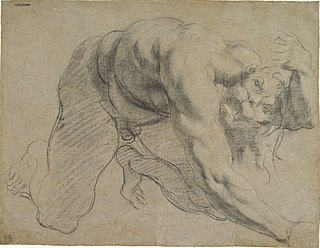
The Palazzo Sampieri frescoes are a set of paintings by Annibale, Agostino and Ludovico Carracci in the Palazzo Sampieri in Bologna. They form the last surviving collection of works by the three artists.
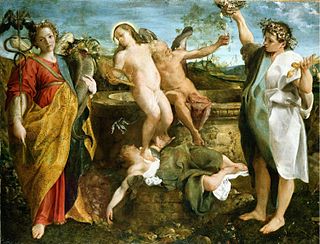
An Allegory of Truth and Time is a 1584-1585 oil on canvas painting by Annibale Carracci, now on display in Hampton Court as part fo the Royal Collection.

The Baptism of Christ is a painting by Annibale Carracci.

Lamentation was a 1587-1590 oil on canvas painting by Annibale Carracci, destroyed with other Carracci works such as Danaë at Bridgewater House in May 1941 during the London Blitz. Prints and copies of it survive, the best being those by the Ferrara painter Francesco Naselli now in Mantua's city library.

Two Children Teasing a Cat is a 1587-1588 oil on canvas painting by Annibale Carracci, now in the Metropolitan Museum of Art in New York, which acquired it in 1994.

Madonna and Child with Saints is a 1588 oil on canvas painting by Annibale Carracci, now in the Gemäldegalerie Alte Meister in Dresden. Signed and dated by the artist, it is also known as Madonna and Child with Saints Francis, Matthew and John the Baptist, Madonna and Child Enthroned with Saint Matthew and the St Matthew Madonna.

Madonna and Child in Glory over the City of Bologna is a c.1593 oil on canvas painting by Annibale Carracci, also known as The Virgin and Child in the Clouds or the Madonna of Bologna. It is now in Christ Church Picture Gallery in Oxford.
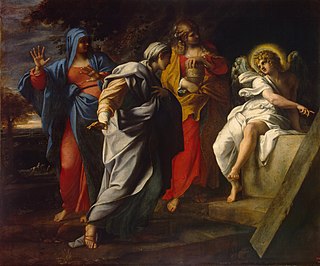
The Three Marys at the Tomb, The Three Marys or The Pious Women at Christ's Tomb is a c.1600 oil on canvas painting by Annibale Carraci, now in the Hermitage Museum in Saint Petersburg, which acquired it in 1836.
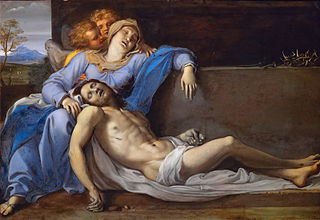
Pietà with Two Angels is a oil on copper painting by Annibale Carracci, created c. 1603, now in the Kunsthistorisches Museum in Vienna.

Pietà with Saints Clare, Francis and Mary Magdalene is a 1585 oil on canvas painting by Annibale Carracci, now in the Galleria nazionale di Parma.
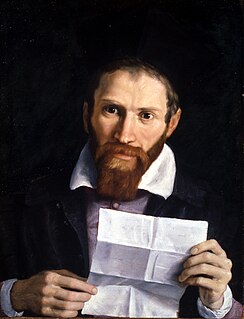
Portrait of monsignor Giovanni Battista Agucchi is a 1604 oil on canvas painting now in York Art Gallery, to which it was presented via the National Art Collections Fund in 1955 by Francis Denis Lycett Green (1893–1959), a collector and younger brother of Sir Edward Arthur Lycett Green, 3rd Baronet. Long attributed to Domenichino, it is now usually attributed to Annibale Carracci, though some art historians still support the old attribution based on archival discoveries The Gallery accepts the new attribution, though this is not yet reflected in its ArtUK entry.

Saint Margaret of Antioch is a 1599 oil on canvas painting by Annibale Carracci, showing Margaret of Antioch. It hangs in Santa Caterina dei Funari church in Rome.





















